

Siphopteron quadrispinosum
Gosliner, 1989
Order: CEPHALASPIDEA
Superfamily: PHILINOIDEA
Family: Gastropteridae
DISTRIBUTION
Originally described from Hawaii & Papua New Guinea. Records on Forum from Japan, New Caledonia, NE Queensland.
PHOTO
Upper: Hawaii. Photo: Scott Johnson
Lower: Chenal de la Passe de Koumac, East side, New Caledonia, 20°40.4'S, 164°14.9'E, 26m, In lagoon, hard substrate 26 October 1993, 1 specimen, 3mm live alive. AM C200653. Photo: Bill Rudman
This species was described from animals collected from Hawaii and Papua New Guinea. In both cases they were yellow with an orange-red siphon and posterior flagellum. There were differences between the two populations. In Papua New Guinea specimens the orange-red on the siphon continued along the edge of the posterior shield, and the edge of the parapodia were yellow, without a coloured margin. Hawaiian animals did not have the orange-red along the margin of the posterior shield but the parapodia had a white margin as in the attached photo.
See message suggesting Siphopteron leah Klussmann-Kolb & Klussmann, 2003 is a probable synonym.
Reference:
• Klussmann-Kolb, A. & Klussmann, A. (2003) A new species of Gastropteridae (Gastropoda, Opisthobranchia, Cephalaspidea) from tropical Northeast Australia. Zootaxa, 156: 1-12
• Gosliner, T.M. (1989): Revision of the Gastropteridae (Opisthobranchia: Cephalaspidea) with descriptions of a new genus and six new species. The Veliger, 32(4): 333-381.
Rudman, W.B., 2004 (January 15) Siphopteron quadrispinosum Gosliner, 1989. [In] Sea Slug Forum. Australian Museum, Sydney. Available from http://www.seaslugforum.net/find/siphquad
Related messages
Re: Siphopteron sp. from the Andaman Sea
May 14, 2010
From: Lawrence Neal
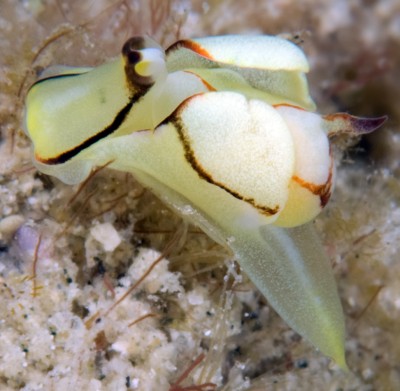
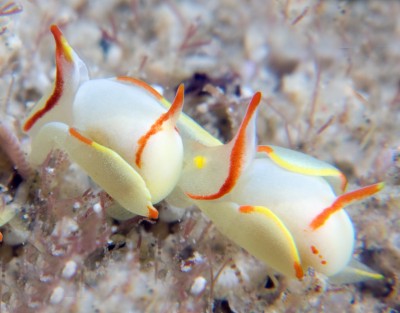
Concerning message #23017:
Dear Bill,
Here are some photos of Siphopteron sp. from the Andaman Sea, northeast Indian Ocean - perhaps variants of S. quadrispinosum? All were found on rocks in around 6 metres of water, close to the shore and all were about the same size, 3 or 4 mm. As you can see there are some similarities and some differences between individuals. The single specimen has lines on the sides of the parapodia. The trailing pair have no lateral lines, but they have a yellow mark close to the eyes, below the siphon.
Do you think the two variants are the same species?
One other observation was the way they crawl. The single individual moved in a 'jerky' fashion (something like Aeolidiella alba), while the trailing pair moved smoothly. Not sure if this is significant or not.
This site on the west coast of Thailand has turned up a few other small bubble shell species, including Siphopteron brunneomarginatum, S. tigrinum, Sagaminopteron ornatum and Colpodaspis thompsoni. Hope to find more in 2010.
Locality: Tablamu, 6 metres, Phangnga, Thailand, Andaman Sea, east Indian Ocean, 25 December 2009, Rocky shoreline. Length: Approx. 4 mm. Photographer: Lawrence Neal.
All the best,
Lawrence
lorenzo_n@yahoo.com
Neal, L., 2010 (May 14) Re: Siphopteron sp. from the Andaman Sea. [Message in] Sea Slug Forum. Australian Museum, Sydney. Available from http://www.seaslugforum.net/find/23035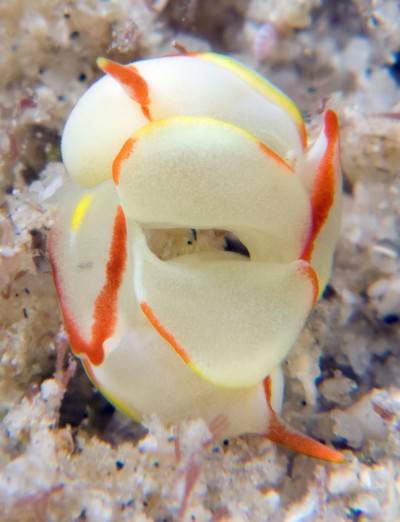
Dear Lawrence,
These animals certainly all seem to be colour variants of a single species, and the most likely choice is Siphopteron quadrispinosum. As this 'species' illustrates, we still have much to learn about colour variation in gastropterids so photos like this are very valuable. if you have photos of the other species of gastropterids you saw they would also be useful additions to the Forum
Best wishes,
Bill Rudman
Research on mating behaviour in Siphopteron
May 14, 2009
From: Rolanda Lange
Concerning message #22458:
Dear forum users,
I am a PhD student in evolutionary biology at the University of Tuebingen, Germany, supervised by Nils Anthes. Using gastropterid sea slugs, especially Siphopteron quadrispinosum, as a model system, I focus on the implications and mechanisms of precopulatory stabbing. Most of my field work will be based at Lizard Island, Australia, where we find Siphopteron quadrispinosum, Siphopteron pohnpei, and Siphopteron sp. 1.
I am on the lookout for potential field sites for the next years and will be more than happy if anyone who commonly sees species of this family will mention it to me.
From what I gather from personal communication, past publications, and the internet Okinawa, PNG, Hawaii, and Guam appear as good field sites.
Moreover, we will try to meet the challenge of finding out what gastropterids feed on. Probably flatworms?
Best wishes,
Rolanda Lange
rolanda.lange@gmail.com
Lange, R., 2009 (May 14) Research on mating behaviour in Siphopteron. [Message in] Sea Slug Forum. Australian Museum, Sydney. Available from http://www.seaslugforum.net/find/22459Dear Rolanda,
Good luck with your research - and I hope you find what these animals are feeding on!
best wishes
Bill
Cephalaspid mating behaviour
April 16, 2008
From: Nils Anthes
Concerning message #21525:
Dear Bill,
We have summarised recent observations on mating behaviour and egg-laying in 29 species (or forms) belonging to the family Aglajidae and 7 species belonging to Gastropteridae in the study listed below. It also contains references to more specific studies on mating strategies in a subset of species such as Chelidonura sandrana, C. hirundinina and Navanax inermis.
I agree that it would be useful to treat the preliminary ID of "S. quadrispinosum" in my previous messsage with care until animals from the Red Sea have been examined morphologically. Unfortunately, I couldn't sample any specimen this time.
-
Anthes, N. & N.K. Michiels (2007): Reproductive morphology, mating behaviour, and spawning ecology in cephalaspid sea slugs (Aglajidae and Gastropteridae). Invertebrate Biology, 124 (4): 335-365.
Best regards
Nils
nils.anthes@uni-tuebingen.de
Anthes, N., 2008 (Apr 16) Cephalaspid mating behaviour. [Message in] Sea Slug Forum. Australian Museum, Sydney. Available from http://www.seaslugforum.net/find/21529Thanks Nils,
Best wishes,
Bill Rudman
Siphopteron quadrispinosum from Red Sea
April 15, 2008
From: Nils Anthes
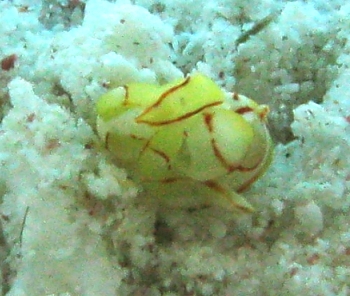
Concerning message #11918:
Dear Bill,
Just want to add a finding that indicates a rather wide distribution of Siphopteron quadrispinosum throughout the Indopacific region. The attached image shows a mating pair of this species that we found near Dahab (Egypt) last week.
Locality: Napoleon reef, Dahab, 3 m, South Sinai, Egypt, Red Sea, 06 April 2008, coral sand. Length: ~ 2 mm. Photographer: Nils Anthes.
By the way, readers interested in the very intriguing mating behaviour of this species (combining hypodermic injection with regular insemination) may be interested in the following publication:
-
Anthes, N. & N.K.Michiels (2007): Precopulatory stabbing, hypodermic injections and unilateral copulations in a hermaphroditic sea slug. Biology Letters, 3: 121-124.
Best regards
Nils
nils.anthes@uni-tuebingen.de
Anthes, N., 2008 (Apr 15) Siphopteron quadrispinosum from Red Sea. [Message in] Sea Slug Forum. Australian Museum, Sydney. Available from http://www.seaslugforum.net/find/21525Thanks Nils,
Even with your message showing colour variation in this species [#11943], I would hesitate to identify this as S. quadrispinosum. If you have any photos of an 'untangled' animal it might be valuable.
Thanks for the reference to your interesting paper. If you have a list of your publications on mating behaviour in the cephalaspids, it would be good to include that as well
Best wishes,
Bill Rudman
Re: Siphopteron quadrispinosum & S. leah
January 19, 2004
From: Terry Gosliner
Hi Bill,
Concerning the current discussion on the Forum about Siphopteron quadrispinosum. After comparing the description of S. leah with that of S. quadrispinosum, there is little question in my mind that they are the same species. The external coloration, radular teeth, form of the penis (with deeply separated prostatic and penial ducts and a penis with few large spines) are unique to these species. The discrepancies noted by Klussman-Kolb and Klussmann, seem relatively minor. It could be that the two spines versus four may represent individual variation or it may be that they did not see the other two spines. Given that they didn't describe the other details of the penial morphology (such as the papilla with smaller spines and the penial papilla with a reticulate spine) it is difficult to be absolutely certain, but they sure look the same.
Terry
tgosliner@CalAcademy.Org
Gosliner, T. M., 2004 (Jan 19) Re: Siphopteron quadrispinosum & S. leah. [Message in] Sea Slug Forum. Australian Museum, Sydney. Available from http://www.seaslugforum.net/find/11942Colour variation in Siphopteron quadrispinosum
January 19, 2004
From: Nils Anthes
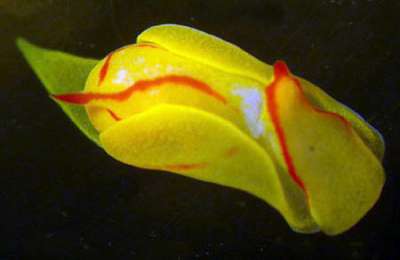
Dear Bill,
Thanks for your comments on Siphopteron quadrispinosum [= Siphopteron spec 3]. Here are some more photos showing some more of the colour variation we found here [Lizard Island, Queensland, Australia - Jan 2004] . Overall, colouration is very constant, but the presence of the various red stripes all over the body varies quite a bit. Concerning the food resource: we tried feeding them the small acoel flatworms that are eaten by Chelidonura sandrana and C. hirundinina but they totally ignored them. The same applies to Siphopteron spec 5, so until now we unfortunately cannot solve the question of what this group feed on.
Best wishes
Nils
anthes@uni-muenster.de
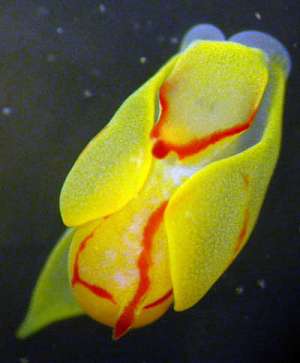
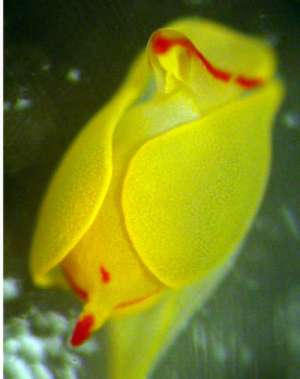
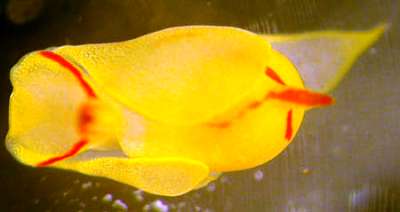
Thanks Nils,
These photos certainly cover a good range of variation. It would be good to see if Hawaiian animals show any variation. I'm sorry you couldn't tempt your animals to eat. I am sure we will be lucky one day.
Best wishes
Bill
Siphopteron quadrispinosum from New Caledonia
January 16, 2004
From: Bill Rudman
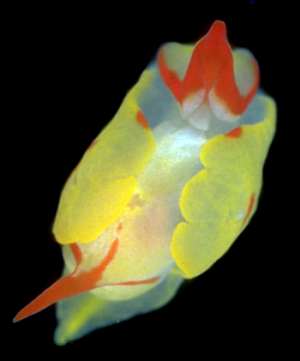
To accompany my discussion on Siphopteron quadrispinosum here is a record of the species from New Caledonia. This is the first time it has been reported from New Caledonia.
• Chenal de la Passe de Koumac, East side, New Caledonia, 20°40.4'S, 164°14.9'E, 26m, In lagoon, hard substrate 26 October 1993, 1 specimen, 3mm live alive. AM C200653
The animal was bright yellow with bright orange marks as shown in the photographs. Of particular interest are the transverse orange marks on the parapodia which can be seen on the right parapodia [in upper right photo] and on the left parapodia [in lower right photo]. These match the tranverse bands seen in the Japanese specimen in Nishina Masayoshi's earlier message.
I have posted a description of the radula in a separate message.
Best wishes
Bill Rudman
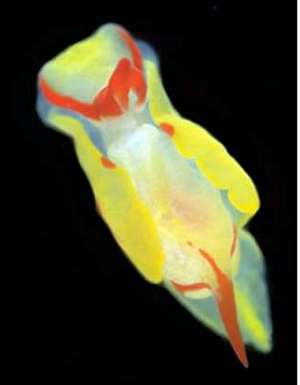
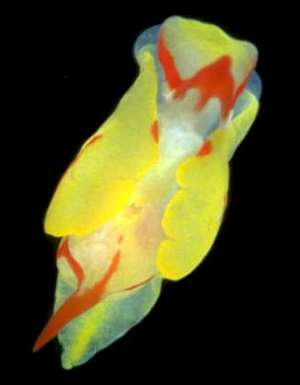
Radula of Siphopteron quadrispinosum from Koumac
January 16, 2004
From: Bill Rudman
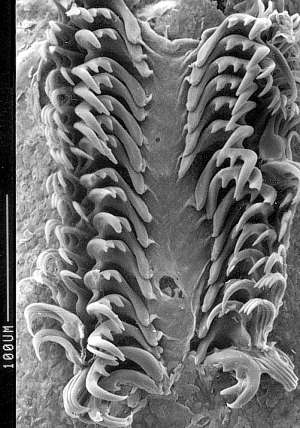
To accompany my report Siphopteron quadrispinosum from Koumac, New Caledonia, here are some scanning electron micrographs of the radula.
The radular formula is 17 x 4.1.0.1.4
PHOTOS:
• Upper right: whole radula. Scale = 100 microns.
• Lower left: section of left half showing outer lateral teeth. Scale = 20 microns.
• Lower right: section showing innermost lateral teeth with two prominent denticles on the cutting edge. Scale = 50 microns.
The two large denticles on the cutting edge of the innermost lateral teeth are characteristic of S. quadrispinosum.
Best wishes,
Bill Rudman
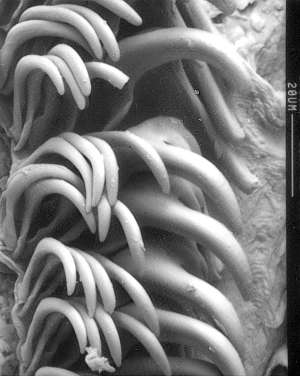
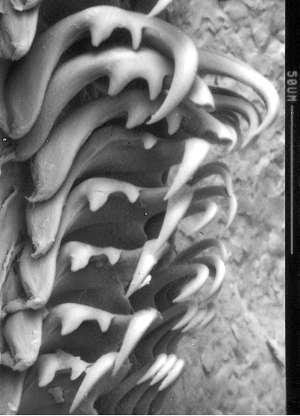
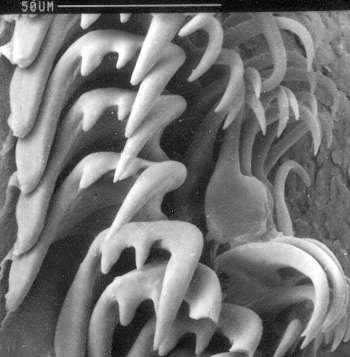
Here is a further electron micrograph showing a section of the right side of radular showing large innermost lateral teeth and smaller outer teeth. Scale = 50 microns.
Siphopteron quadrispinosum & S. leah
January 16, 2004
From: Bill Rudman
Following Nils Anthes' recent message I have restudied the descriptions of Siphopteron quadrispinosum Gosliner, 1989 and S. leah Klussmann-Kolb & Klussmann, 2003 and come to the conclusion that they are most probably the same species. Their colour pattern and radular morphology are both very similar, if not identical, and there are no other species in the family with similar characteristics. The one feature which separates them is that Siphopteron quadrispinosum has 4 large spines in a secondary penial sac and S. leah has 2. If we look at the family broadly, these two species are the only two in the family in which the prostate and penial ducts are so deeply separated and which have these large spines. At this stage I would think it more reasonable to assume that the number of penial spines may be variable or that the specimen examined by Klussmann-Kolb & Klussmann was aberrant. Gosliner described his species from both Hawaiian animals and animals from Papua New Guinea. Klussmann-Kolb & Klussmann discuss the similarities between Siphopteron quadrispinosum and S. leah and suggest that the colour differences between Hawaiian and Papua - New Guinean species suggest that Gosliner had two species in his description, and the Paua New Guinean were possibly S. leah.
However in Gosliner's description he examines and illustrates the reproductive organs of both populations and shows they both have 4 spines.
I therefore consider that the animals at present on the Forum as Siphopteron sp. 3 are S. quadrispinosum and that S. leah is a synonym. Although the animal from Japan in Nishina Masayoshi's message is more heavily marked than others from elsewhere in the Pacific on the Forum, if you look at both Nils Anthes photo from the Great Barrier Reef and my photo from New Caledonia, there is a remnant of the orange-red line which runs across the parapodia in the Japanese specimen which clearly links the colour patterns of these three.
In an earlier comment on photos from Scott Johnson of Hawaiian animals, I mentioned that the structure of the siphon looked abnormal. On further examination I think the apparent peculiarity is an illusion caused by the angle at which the animal has been photographed.
• Klussmann-Kolb, A. & Klussmann, A. (2003) A new species of Gastropteridae (Gastropoda, Opisthobranchia, Cephalaspidea) from tropical Northeast Australia. Zootaxa, 156: 1-12
Best wishes
Bill Rudman
Siphopteron sp. 3? from Great Barrier Reef
January 14, 2004
From: Nils Anthes
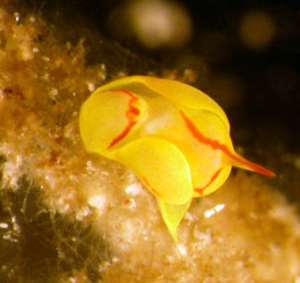
Note added 15 January 2004: This is considered to be Siphopteron quadrispinosum. See message.
Dear Bill,
This little Siphopteron [Siphopteron sp. 3 on the Forum] with only 1.5-5 mm body length (adults!) is currently quite abundant in algal patches around Lizard Island (QLD, Australia) in shallow water depths. Their colouration is rather constant, there is only little variation in which of the red stripes on the posterior shield, head shield and parapods are present.
Interestingly, Marshall & Willan's Heron Island book has a colour drawing of a Gastropteron with exactly the same colour pattern. I wonder whether this is really some sort of convergent colour pattern, or whether they missed the ridge in the siphon (their drawing clearly shows none, while the animals found here conspicuously have one; see also my separate message to another species of Siphopteron.
Best wishes
Nils
anthes@uni-muenster.de
Anthes, N., 2004 (Jan 14) Siphopteron sp. 3? from Great Barrier Reef. [Message in] Sea Slug Forum. Australian Museum, Sydney. Available from http://www.seaslugforum.net/find/11844Dear Nils,
I am interested in your comment about many animals. If you have photos of other colour variants they would be very welcome. If there are animals with red lines on the parapodia like the ones from Japan that would be quite a good link. For that matter any colour variants would be useful. The other thing it would be nice to know is what they eat! I wouldn't be surprised if they eat small flatworms like your little Chelidonura species so if you have the opportunity a little test could solve a long-standing riddle
I am pretty sure your animal is the recently described Siphopteron leah Klussmann-Kolb & Klussmann, 2003 but I can't find a copy of the description at the moment so am a little hesitant to be definite until I read it again. It was collected in Nth Queensland, and from memory, has a bright yellow body with red lines along the siphonal crest, the parapodia, across the visceral hump and along the flagellum.
Although I am in no position to speak for Marshall & Willan, my first thought would be that their Gastropteron sp. 1 is the same species and the siphonal ridge was missed. It seems the 2.5mm long specimen was collected by a third party during survey work and painted by someone who may not have noticed or realised the significance of a ridge in the tiny siphon. I suspect at that size, the ridge would have been very difficult, if not impossible, for Marshall & Willan to see in the preserved animal.
• Klussmann-Kolb, A. & Klussmann, A. (2003) A new species of Gastropteridae (Gastropoda, Opisthobranchia, Cephalaspidea) from tropical Northeast Australia. Zootaxa, 156: 1-12
Best wishes
Bill Rudman
Is this Siphopteron quadrispinosum?
May 27, 2002
From: Nishina Masayoshi
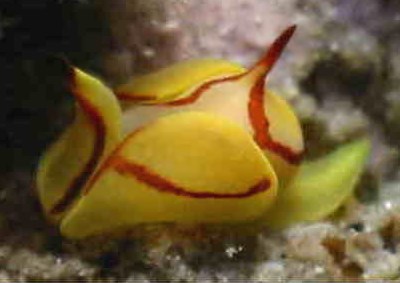
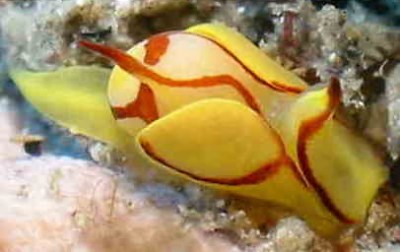
Note added 15 January 2004: This is considered to be Siphopteron quadrispinosum. See message.
Dear Bill,
My friend Moguricyo sent me these photos. I am sure that this animal belongs to
Siphopteron, but I have no idea what species. It might be Siphopteron quadrispinosum?
Date: 20 May, 2002
Location: Hachijo Island Japan
Length: 5mm
Found and Photo by Moguricyo
Best Regards,
Nishina Masayoshi
nishina@wips.co.jp
Masayoshi, N., 2002 (May 27) Is this Siphopteron quadrispinosum?. [Message in] Sea Slug Forum. Australian Museum, Sydney. Available from http://www.seaslugforum.net/find/7025Dear Nishina,
It certainly has similarities in colour to Siphopteron quadrispinosum but at present I wouldn't like to say just how much colour variation we should expect to occur in some of these yellow species of Siphopteron and Gastropteron. In this case, I think the colour pattern is so different from existing species that it is probably something unnamed. It is possible that the red lines could darken to brown or even black, but even then I don't know of a species with such markings. I think to be safe I will call it Siphopteron sp. 3.
Best wishes,
Bill Rudman
Re: Mystery from Hawaii
August 26, 2001
From: Scott Johnson

Hi Bill,
I think David Kearns' mystery is a Siphopteron as you suggest. Here is a shot from Hawaii of what I've been calling Siphopteron quadrispinosum. These were part of a similar population bloom observed in the late 70s.
Scott
johnson@kmr.ll.mit.edu
Dear Scott,
What an interesting animal. My only doubt about it being a gastropterid was David's mention of a single rhinophore dividing in two. Now I have seen your photo I can see his description was pretty accurate - especially for something the size of a grain of rice.
Terry Gosliner doesn't mention this unusual double 'siphon' in his description and his colour photo, which from its colour must be from Hawaii, seems to have a single siphon, so it will have to remain another little mystery until someone can have a look at the anatomy of an animal with a bifid siphon.
Thanks again,
Bill Rudman
Mystery from Hawaii
August 25, 2001
From: David Kearnes
I have observed many tiny (grain of rice sized, 1mm) sea slugs, don't know what family. They are lemon yellow, the lateral flaps that fold over their back are margined in white, and they have dark red rhinophores that appear to originate from a single stalk and then branch to two points. Where the gills should be is what looks like a single dark red point. They were observed from 90 ft of water to about 25 ft. We live in Hawaii, dive weekly for several years and this is the first time we've seen them and they are everywhere. Don't know if this event is related but it is that time of year that the lined sea hare, Stylocheilus longicauda is in great numbers. I've searched the site but have not had luck.
Dave Kearnes.
Jillj@kona.net
Kearnes, D., 2001 (Aug 25) Mystery from Hawaii. [Message in] Sea Slug Forum. Australian Museum, Sydney. Available from http://www.seaslugforum.net/find/4981Dear Dave,
I am wondering whether your mystery beast is a species of Gastropteron or the related Siphopteron. If the 'rhinophore' you describe didn't branch, it woud be a reasonable description for the anterior siphon. Go to the Species List and have a look at photos of a few of the species. It will at least enable you to decide whether the shape is right or not. If not, perhaps a rough drawing would help me.
By the way, the lined sea hare you mention has had a name change. Stylocheilus longicauda is in fact a yellow unlined species, the lines species being Stylocheilus striatus. The reason are discussed on a separate page on the Forum
Best wishes,
Bill Rudman.
